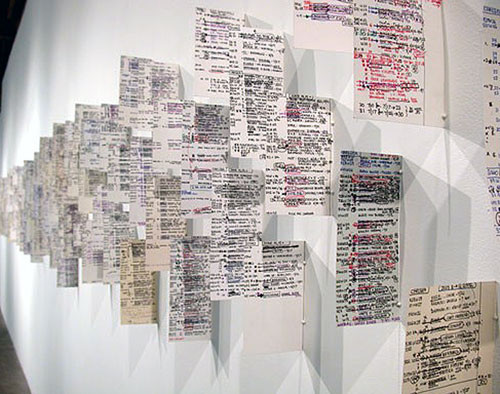<< 
{click on image to view more}
Kim Levin: Itineraries
Curated by John Salvest
Delta Axis @ Marshall Arts
Memphis, Tennessee, USA
October 17-November 22, 2003
visit
website | download
article (pdf) Art Papers, March/April
2004, by David Hall
Jonesboro, Arkansas artist John Salvest met KIM LEVIN, art critic
and longtime writer of the weekly exhibition listings for The
Village Voice, when she was guest curator for "Max: 98"
at the University of Memphis. One of the critical favorites of the
exhibition that Levin delivered was Salvest's Meditation 7:21,
a mosaic of countless business cards of every color and variety
enveloping several of the gallery's steep walls. Perched above the
room, the aggregate of business cards formed a colossal banner whose
scale and sentiment suggested biblical poignancy: "Soon you
will have forgotten the world and soon the world will have forgotten
you."
"Itineraries" (Marshall
Arts, October 17–November 22, 2003) represents a turning
of the tables. Salvest is the curator this time around, bringing
to light scribbled notes, sketches, postcards and other literature
accumulated by Levin during more than a decade of covering the New
York art scene. While visiting the city several years ago, Levin
invited Salvest to tag along on her rounds, where he first observed
her idiosyncratic lists and jottings, tiny road maps drawn on Post-It
notes and the like. "Incurably predisposed as I am toward the
obsessive and systematic," Salvest confesses in the curator's
statement, "I found these little documents irresistible. But
more tan that, I felt as though I had stumbled upon an archive of
remarkable interest."
Upon entering the cavernous gallery,
one is awestruck at the prodigious volume of materials, notwithstanding
that the exhibition employs only a fraction of the archive. The
documents are grouped for display according to their particular
function or defining characteristic, although Levin's mechanism
relies upon the interdependence of the entire coterie. The meticulously
detailed lists assume a symbolic potency when seen en masse, as
do the rows and rows of besmudged mailings and brochures of
Notes I and Cards. Here, it is evident that field observations
and illustrative reminders are scrawled on whatever printed matter
is handy, which steadily accumulates. There is even a collection
devoted to oddballs, Notes II, a row of artifacts that are
trapezoidal, full of holes or otherwise do not follow any standard
size or shape.
Lists I exhibits hundreds of
weekly travel itineraries chronologically, each following a standard
weekly travel itineraries chronologically, each following a standard
format prioritized by destination and other categories. The very
need for such a device to manage the outings indicates the utter
magnitude of the New York exhibition circuit and the awesome task
Levin has in representing it. Entries are color-coded, numbered,
scratched through or circled, a method seemingly refined over the
course of time for maximum efficiency. Salvest uses a no-nonsense
technique to suspend each itinerary along its featheredge and then
staggers the lot of them along the wall rhythmically so that both
sides are easily viewed. Thanks to the imaginative installation,
the cumulative impact is visceral rather than merely documentary,
amplified by all those columns jumping off the wall.
But it also looks mighty familiar.
Salvest the artist has long been recognized as a packrat–salvaging,
cataloging and recapitulating the simplest of objects: nail clippings,
spent coffee filters, cigarette butts, business cards; you name
it. He always finds his lyrical pearl within the commonplace. The
serial objects in the case are Levin's, but they too convey very
authentically life's lowly routines, its beauty, banality and ultimate
transience. The fact is, Salvest is written all over "Itineraries"
both conceptually and aesthetically, so much so that one wonders
why he doesn't share equal billing with Levin. << |